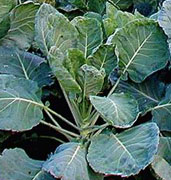


Home
Flowers &
Indoor Plants
Fruits & Nuts
Ornamentals
Vegetables
Special Topics
Resources
Glossary

|
Collards (Acephala Group) Brassica oleracea (brass-ih-cah o-ler-ay-see-ah) 

Click on thumbnails for larger image. |
 |
What about it? Collards are a cool-season vegetable, rich in vitamins A and C and relatively high in protein. Collards are related to kale and they are said to lower blood cholesterol and the risk of certain types of cancer. What is it used for? Collards are grown for their leaves. Where does it grow? How do we grow it? Collards thrive in loamy soil with a pH of 5.5 to 6.8. They need a good supply of water and nutrients for lush growth Collards are easily started from seeds and can be sown directly in the garden beds. Plant collard seeds 1/4 to 1/2 inch deep, 4 to 5 seeds per foot of row. Allow 3 feet between rows since the plants get large, or plant in wide rows. After 3 weeks the plants should be thinned to stand 6 to 12 inches apart. What are its primary problems? Flea beetles, imported cabbageworms, aphids, and cabbage root maggots may bother the crop. How do we harvest and store it? All the green parts of the plant are edible, although many gardeners cut only the inner rosette of young growth. You can also wait until the plants are a foot high and then pick the largest leaves, allowing the younger leaves to develop. Plants can be retained from spring through fall by harvesting lower leaves and leaving several leaves at the top to continue the growth. Leaves may be harvested at any time, but it is recommended they be from 5 to 8 inches long. Old leaves may become too bitter and tough to eat. Collard leaves lose moisture and wilt rapidly. After harvest in the garden they should be shaded and cooled immediately. They can be misted or put in a container with crushed ice to keep them fresh When stored in a refrigerator in a perforated plastic bag, these leafy greens will keep at least 2 weeks.
© Copyright, Department of Horticulture, Cornell University. |